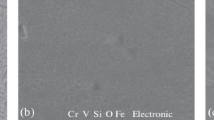Conclusions
-
1.
The velocity dependence of dynamic fracture toughness can be evaluated by the method of quantitative stereoscopic fractography within a broad range of loading rates.
-
2.
For steel 40Kh the ascending branch of the velocity dependence of KId is determined by fragmentation of the structure causing ramification of the crack which, in the final analysis, increases fracture toughness. The reduced size of the microcrack in fragmentation is directly connected with the weakening of the dependence of crack resistance on the loading rate [19], which in our experiments corresponds to the range of impact speeds of 300–600 m/sec.
-
3.
Removal of microsegregations from the boundaries forming upon fragmentation of blocks in the structure (by means of diffusion) increases the surface energy of such boundaries, impedes the formation of microcracks on them, and consequently increases fracture toughness.
Similar content being viewed by others
Literature Cited
J. R. Klepaczko, “Discussion of a new experimental method in measuring fracture toughness initiator at high loading rates by stress waves”, J. Eng. Mater. Technol.,104, No.1, 29–35 (1982).
J. M. Krafft, “Correlation of plane strain crack toughness with hardening characteristics of a low, a medium and a high strength steel”, Appl. Mater. Res., No. 4, 88–101 (1964).
K. Turner, “Measurement of fracture toughness in impact tests with oscillographing”, in: Impact Tests of Metals [Russian translation], Mir, Moscow (1973), pp. 100–122.
S. Dalela, “Material response at different strain-rates”, Precis. Eng.,2, No. 1, 13–16 (1980).
G. V. Stepanov and V. A. Makovei, “Determination of characteristics of fracture toughness under impact loading”, Probl. Prochn., No. 9, 80–84 (1982).
V. A. Makovei, “Determination of dynamic characteristics of fracture toughness on annular specimens with the aid of a vertical impact tester”, Probl. Prochn., No. 6, 97–100 (1984).
G. V. Stepanov and V. A. Makovei, “The effect of the loading rate on the crack resistance of hardened steel”, Probl. Prochn., No. 6, 31–35 (1984).
A. Ya. Krasovskii, V. A. Stepanenko, and N. D. Bega, “Application of scanning electron microscopy in the quantitative stereofractographic analysis of fatigue fractures”, Probl. Prochn., No. 6, 35–38 (1977).
H. C. Rogers, “Adiabatic shearing—general nature and material aspects,” in: Mater. Behavior under High Stress and Ultrahigh Load Rates, Pergamon Press, New York (1983), pp. 101–118.
P. A. Arack, “Temperature study of the dynamic strain compression test,” in: Proc. 24 Int. Mach. Tool. Des. and Res. Conf., Manchester, 31 Aug.–1 Sept. 1983, Manchester etc. (1984), pp. 31–36.
V. A. Pavlov, O. V. Antonova, and A. P. Adakhovskii, “Mechanical properties and structure of metals and alloys with maximal degree of plastic deformation,” Fiz. Met. Metalloved.,58, No. 1, 177–184 (1984).
V. I. Vladimirov and A. E. Romanov, “Discrimination approach to plastic deformation,” Fiz. Elektron. Tverd. Tela, No. 5, 3–10 (1982).
V. V. Rybin, Large Plastic Deformations and Failure of Metals [in Russian], Metallurgiya, Moscow (1986).
V. A. Strel'tsov, B. M. Éfros, and S. V. Gladkovskii, “The effect of delocalization of plastic deformation on the fracture of metastable manganese base steels,” in: The Role of Defects in the Physicomechanical Properties of Solids: Abstracts of Papers of a Seminar, September 10–12, 1985, Barnaul, Part 1, Altaiskii Politekhnicheskii Institut, Barnaul (1985), p. 96.
K. S. Koffy and R. V. Armstrong, “The formation of regions of overheating in zones of shear localization in impact tests,” in: Shock Waves and Phenomena of High-Speed Deformation of Metals [in Russian], Metallurgiya, Moscow (1984), pp. 89–98.
Y. Horie, “Some thermodynamical influences of defects in shock-loaded solids,” in: Shock Waves Cond. Matter: Proc. Am. Phys. Soc. Conf., Santa Fe, July 18–21, 1983, Amsterdam etc. (1984), pp. 369–373.
J. F. Knott, “Effects of microstructure on the fracture toughness of metallic alloys,” in: Adv. Fract. Res., Proc. 6th Int. Conf., New Delhi, 4–10 Dec., 1984, Vol. 1, Oxford etc. (1984), pp. 83–103.
D. Firrao and R. Roberti, “Interrelation among microstructure, crack-tip blunting and ductile fracture toughness in mild steels,” in: Adv. Fract. Res., Proc. 6th Int. Conf., New Delhi, 4–10 Dec., 1984, Vol. 2, Oxford etc. (1984), pp. 1311–1319.
H. Homma and D. A. Shockey, “Response of cracks in structural materials to short pulse loads,” J. Mech. Phys. Solids,31, No. 3, 261–279 (1963).
Additional information
Institute of Strength Problems, Academy of Sciences of the Ukrainian SSR, Kiev. Translated from Problemy Prochnosti, No. 2, pp. 3–8, February, 1988.
Rights and permissions
About this article
Cite this article
Krasovskii, A.Y., Makovei, V.A., Nadezhdin, G.N. et al. Analysis of the velocity dependence of fracture toughness in pulsed loading of steel 40Kh. Strength Mater 20, 137–142 (1988). https://doi.org/10.1007/BF01522911
Received:
Issue Date:
DOI: https://doi.org/10.1007/BF01522911




